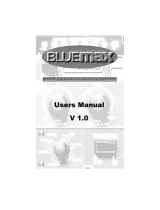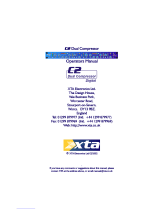
PreSonus Limited Warranty
PreSonus Audio Electronics Inc. warrants this product to be free of defects in material and workmanship for a period of one year from the date of original retail
purchase. This warranty is enforceable only by the original retail purchaser. To be protected by this warranty, the purchaser must complete and return the
enclosed warranty card within 14 days of purchase. During the warranty period PreSonus shall, at its sole and absolute option, either repair or replace, free of
charge, any product that proves to be defective on inspection by PreSonus or its authorized service representative. To obtain warranty service, the purchaser
must first call or write PreSonus at the address and telephone number printed below to obtain a Return Authorization Number and instructions of where to return
the unit for service. All inquiries must be accompanied by a description of the problem. All authorized returns must be sent to the PreSonus repair facility postage
prepaid, insured and properly packaged. PreSonus reserves the right to update any unit returned for repair. PreSonus reserves the right to change or improve the
design of the product at any time without prior notice. This warranty does not cover claims for damage due to abuse, neglect, alteration or attempted repair by
unauthorized personnel, and is limited to failures arising during normal use that are due to defects in material or workmanship in the product. Any implied
warranties, including implied warranties of merchantability and fitness for a particular purpose, are limited in duration to the length of this limited warranty. Some
states do not allow limitations on how long an implied warranty lasts, so the above limitation may not apply to you. In no event will PreSonus be liable for
incidental, consequential or other damages resulting from the breach of any express or implied warranty, including, among other things, damage to property,
damage based on inconvenience or on loss of use of the product, and, to the extent permitted by law, damages for personal injury. Some states do not allow the
exclusion of limitation of incidental or consequential damages, so the above limitation or exclusion may not apply to you. This warranty gives you specific legal
rights, and you may also have other rights, which vary form state to state. This warranty only applies to products sold and used in the United States of America.
For warranty information in all other countries please refer to your local distributor. Limited Warranty Outside of The U.S. PreSonus Audio Electronics products are
warranted only in the country where purchased, through the authorized PreSonus distributor in that country, against defects in material and workmanship. The
specific period of this limited warranty shall be that which is described to the original retail purchaser by the authorized PreSonus dealer or distributor at the time of
purchase. PreSonus does not, however, warrant its products against any and all defects: 1) arising Out of materials or workmanship not provided or furnished by
PreSonus, or 2) resulting from abnormal use of the product or use in violation of instructions, or 3) in products repaired or serviced by other than authorized
PreSonus repair facilities, or 4) in products with removed or defaced serial numbers, or 5) in components or parts or products expressly warranted by another
manufacturer. PreSonus agrees, through the applicable authorized distributor, to repair or replace defects covered by this limited warranty with parts or products of
original or improved design, at its option in each respect, if the defective product is shipped prior to the end of the warranty period to the designated authorized
PreSonus warranty repair facility in the country where purchased, or to the PreSonus factory in the U.S., in the original packaging or a replacement supplied by
PreSonus, with all transportation cost and full insurance paid each way by the purchaser or owner. All remedies and the measure of damages are limited to the
above services. It is possible that economic loss or injury to person or property may result from the failure of the product; however, even if PreSonus has been
advised of this possibility, this limited warranty does not cover any such consequential or incidental damages. Some states or countries do not allow the limitations
or exclusion of incidental or consequential damages, so the above limitation may not apply to you. Any and all warranties, express or implied, arising by law,
course of dealing, course of performance, usage of trade, or otherwise, including but not limited to implied warranties of merchantability and fitness for a particular
purpose, are limited to a period of two years from either the date of original retail purchase or, in the event no proof of purchase date is available, the date of
manufacture. Some states or countries do not allow limitations on how long an implied warranty last, so the above limitations may not apply to you. This limited
warranty gives you specific legal rights, and you may also have other rights which vary from state to state, country to country.
PreSonus Audio Electronics, Inc.
7257 Florida Blvd.
Baton Rouge, LA 70806
(225) 216-7887
Copyright 1998, 2000, 2001, 2007 PreSonus Audio Electronics, Incorporated. All rights reserved.























